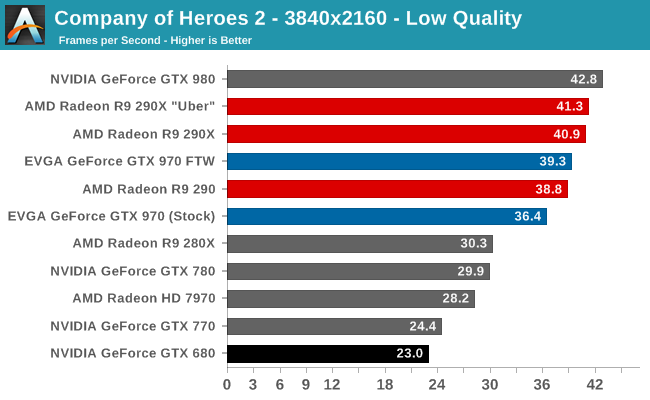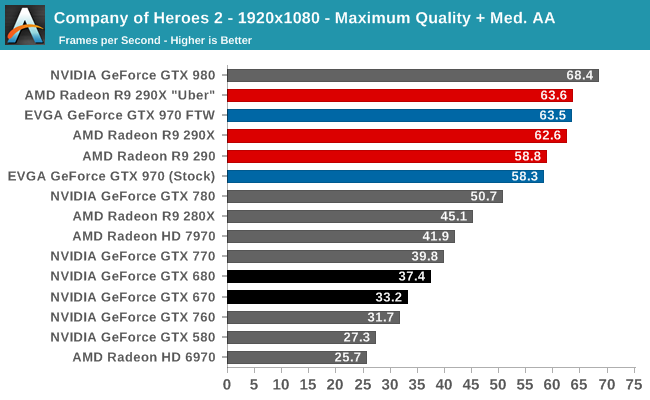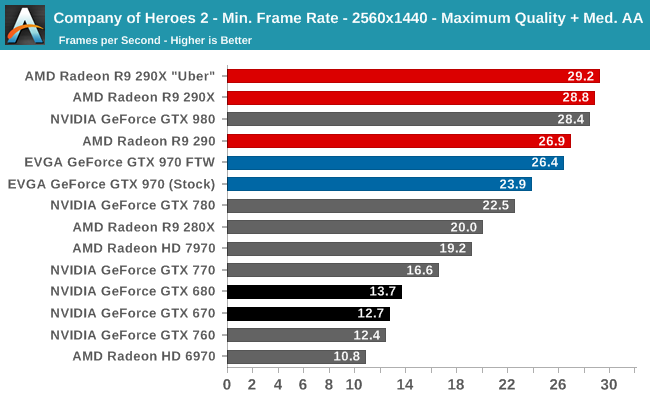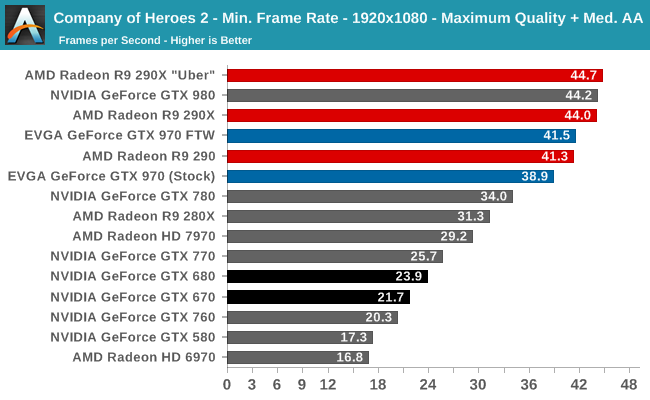The NVIDIA GeForce GTX 970 Review: Featuring EVGA
by Ryan Smith on September 26, 2014 10:00 AM ESTCompany of Heroes 2
Our second benchmark in our benchmark suite is Relic Games’ Company of Heroes 2, the developer’s World War II Eastern Front themed RTS. For Company of Heroes 2 Relic was kind enough to put together a very strenuous built-in benchmark that was captured from one of the most demanding, snow-bound maps in the game, giving us a great look at CoH2’s performance at its worst. Consequently if a card can do well here then it should have no trouble throughout the rest of the game.



Company of Heroes 2 was one of the only games that the GTX 980 didn’t take a significant lead in, and consequently it’s one of the few games that GTX 970 will lose by a significant margin. With the exception of 1080p the stock GTX 970 can’t keep pace with the R9 290, let alone the R9 290XU. Overall NVIDIA’s second-tier card will trail the AMD flagship by 12%, which in the grand scheme of things is still going to be much narrower than the price difference.
In this case Company of Heroes 2 seems especially fond of shader performance. So the GTX 970 drops off by a bit more than in most other games, coming in at just 85% of the performance of GTX 980.



With AMD already doing well on minimum framerates against the GTX 980, against the GTX 970 NVIDIA ends up further behind. When push comes to shove in this game’s hardest scenes, the GTX 970 buckles a bit more than the competition.










155 Comments
View All Comments
AkibWasi - Saturday, September 27, 2014 - link
ain't those 896(64 per SMM) yellow colored boxes in Titan's diagram indicate FP64 cores ???Ryan Smith - Saturday, September 27, 2014 - link
Correct. NVIDIA only includes those cores on diagrams for their compute/pro GPUs.dexgen - Friday, September 26, 2014 - link
I think it would be a great idea to comment on and analyze the effects of overclocking (extra OC through AB or PX) when even the non overclocked settings end up getting throttled.For me, the most important thing about overclocking when the card is factory overclocked already is how much the throttling changes when the power target is increased. Any comments, Mr. Smith?
Ryan Smith - Friday, September 26, 2014 - link
Increasing the power target helps, but it does not fully alleviate the issue. A 10% increase just isn't enough to eliminate all TDP throttling, thanks in big part to the fact that power consumption grows with the square of the voltage. GM204 would ideally like quite a bit of power to sustain a heavy workload at 1.243v. Which is why that's officially in boost territory, as NVIDIA only intends that voltage/bin to be sustained in light workloads.Alexvrb - Saturday, September 27, 2014 - link
Wow I figured that the 970 would run into far less issues sustaining max boost than the 980. But I guess it is drawing nearly as much power. I don't want to see anyone complaining about AMD cards and boost anymore, heh.Anyway, the 970 still provides the absolute best bang for the buck and I'm stunned they didn't price it at $400. It's fast, reasonably priced, runs cool and quiet. It also is easy on power requirements, though I always overbuy on PSU anyway for headroom. Easy recommendation for anyone buying in the this price range!
AnnonymousCoward - Saturday, September 27, 2014 - link
Square of voltage, what are you smoking? P = IV = I^2 R = V^2 /R. The IC isn't a resistor. Typically current stays close to the same as you increase supply voltage.Ryan Smith - Saturday, September 27, 2014 - link
The formula for dynamic power consumption:P = C * V^2 * f
Where C is capacitance, f is frequency, and V is voltage. Those high boost bins are very expensive from a power standpoint.
AnnonymousCoward - Sunday, September 28, 2014 - link
You're right, thanks! Thinking about it, dynamic power increases by the square, and static is by a direct proportion, so total should be between the two. Dynamic probably dominates so it's probably much closer to the square.Footman36 - Friday, September 26, 2014 - link
What really bothers me is that EVGA is getting lazy, reusing older pcb's. This one looks like a 760... The VRM and phases look very primitive next to a card like the Asus Strix GTX 970. There was a time when EVGA used to wow me with custom designs, the last few years not so much as they invariably use reference boards. the issue I have with most of the reference boards is that coil buzz is noticeable. The Asus and MSI boards are using custom digital VRM's and super alloy caps....Anyhow, nice review.
Iketh - Monday, September 29, 2014 - link
i'm sure it has to do with their big heat sink design + bracing so the card doesn't flex